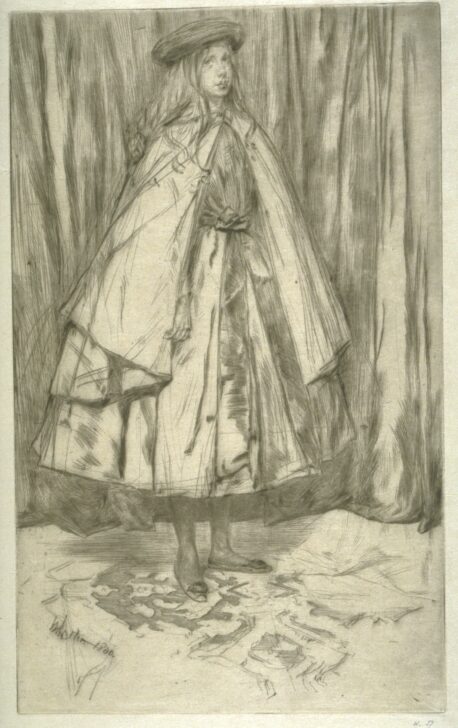Annie Haden
James Abbott McNeill Whistler

Description
Annie Haden
1860
Drypoint
Third state of three (Kennedy 62)
Bequest of Margaret Watson Parker, 1954/1.344
In this portrait, twelve-year-old Annie Haden is shown in a pose derived from earlier conventions of aristocratic portraiture by the Spanish painter Diego Velázquez (1599–1660); she wears a hat and cape as if she is about to go out. Despite the overall patterning of the garments, rug, and drapery, here Whistler focuses interest on his niece’s face, capturing with the most delicate lines and a touching sympathy her slightly tentative and perhaps melancholic expression.
The artist considered Annie Haden to be one of his most important prints. Indeed, asked to make a decision about which was his best, he replied that he would “rest his reputation on Annie Haden,” and he chose to include it in the retrospective of his work at the World’s Fair of 1900 in Paris, at which he was awarded the grand prize in etching. The silvery tonalities of this drypoint were particularly prized by the artist, and he sought to emulate them years later in his lithographs.
----
March 28, 2009
Whistler’s affection for his sister’s children is evident in this portrait of his niece, Annie Haden, shown standing in hat and cape before a curtain. The portrait of Annie recalls Velázquez’s full-length portrait etchings that Whistler had admired at the Manchester Art Treasures Exhibition in 1857, but Whistler has translated that venerable portrait type into an image that is both contemporary and deeply personal. The depiction is dominated by patterning and fluid linework—of the dress, of the drapery in the background, and of the partially described carpet at Annie’s feet. In spite of all of this visual activity, it is the delicately rendered and slightly mournful features of a girl on the brink of adolescence that arrests the eye. Whistler considered Annie Haden to be one of his finest etchings and in 1900 specified that an impression of this image be included in a show of his work at the Paris Exposition Universelle of that year. It is executed entirely in drypoint, a medium in which only a handful of impressions can be pulled before the rich raised burr of displaced copper is flattened in printing.
Subject Matter:
Whistler was very fond of the children of his half-sister, Deborah Haden. She and her husband, the surgeon and amateur printmaker Francis Seymour Haden, lived in London and Whistler spent a lot of time with the family. He drew and painted his sister and her children numerous times in the late 1850s and early 1860s. This portrait of his niece Annie was drawn when the sitter was about 12 years old.
Whistler admired the paintings of Velázquez and here Whistler incorporated some of the conventions of aristocratic portraiture that he valued in the Spanish painter's work. However, despite the formality of the pose, Whistler's drypoint shows his touching empathy and affection for Annie. The face captures all the tentative self-consciousness of the young woman with the most delicate lines. Years later, even as late as 1900, when Whistler was asked if his reputation as a printmaker had to rely on only one of his works, he said that he'd stake his reputation on this plate of Annie Haden.
Physical Description:
A girl with long loose hair stands on a carpet in front of drapery. She is wearing a straw hat and cape over her dress; she is wearing flat shoes with rosettes on the top. She stands facing slightly to the left, although her eyes look at the viewer. Her left hand is not visible and her right hand holds the edge of her cape.
Usage Rights:
If you are interested in using an image for a publication, please visit https://umma.umich.edu/request-image/ for more information and to fill out the online Image Rights and Reproductions Request Form.